Exploring Kyushu: Japan's southernmost island

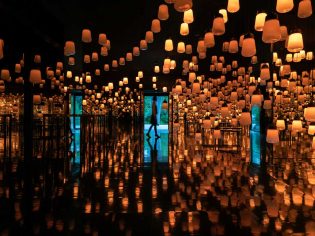
The otherworldly teamLab installation Ruins and Heritage: Rinkan Spa & Tea Ceremony at Mifuneyama Rakuen Hotel in Saga Prefecture. (Image: Courtesy of teamLab)
On a Japanese island of behemoth volcanic mountains and endless seas, huge allures can be found in the small and the unexpected.
Mifuneyama Rakuen is a pleasure garden sprawling over 500,000 square metres at the base of Mt Mifune in Saga Prefecture on the Japanese island of Kyushu.
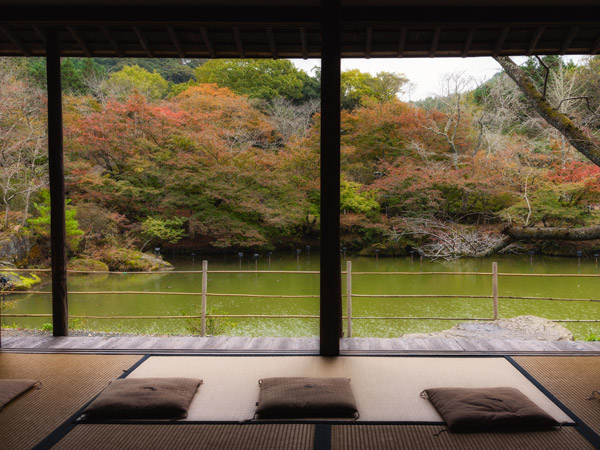
Mifuneyama Rakuen Gardens were created in 1845.
Created for the former feudal lord Shigeyoshi Nabeshima in 1845, the position of the garden was brilliantly calculated; the mountain creates the perfect backdrop, appearing to be part of the garden without the burden – or price tag – of ownership.
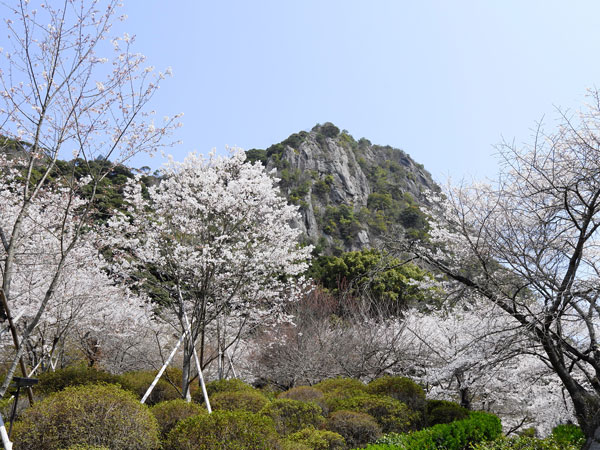
Sakura is a famous sight in Mifuneyama Rakuen.
What makes Kyushu a blissful place?
The ‘borrowed’ panorama creates a stunning first impression, and while the azaleas that drench the garden in colour during spring are absent, the vivid autumn hues of orange, yellow and red are equally arresting.
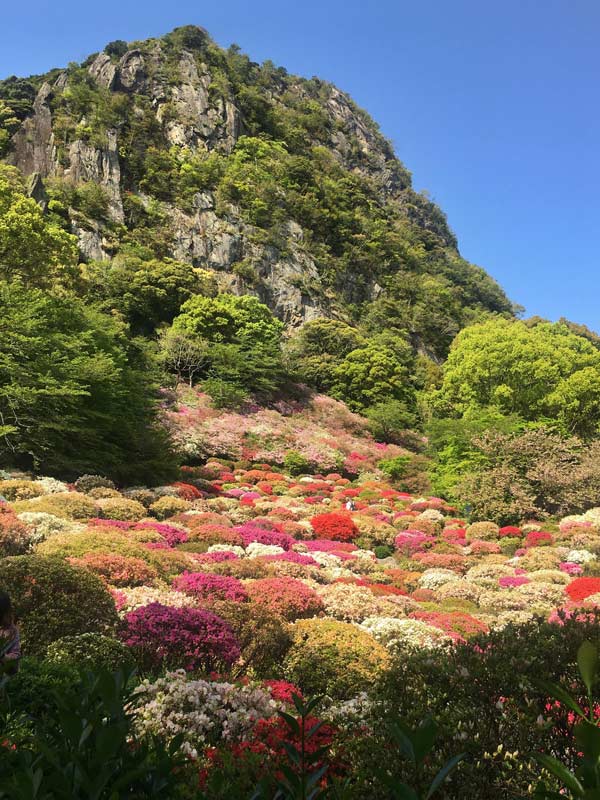
The transient garden is captivating in all seasons.
Wandering the tiered terraces, weaving through a maze of low-manicured hedges, I am blissfully engulfed in the silence and solitude of nature, removed from the technology and affections of the modern as if I have stepped back in time.
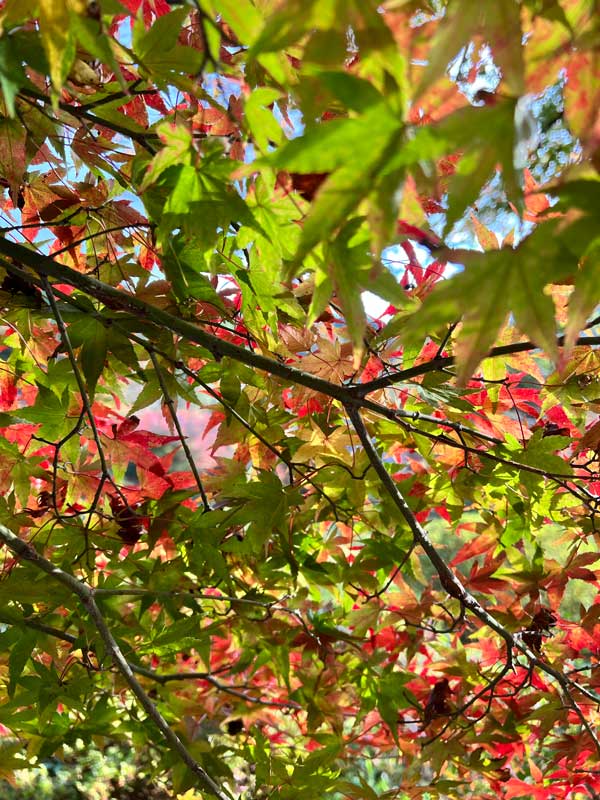
Vibrant azaleas bloom in spring to rich shades of autumn.
Then I see it, an unassuming sign, almost apologetic in its humbleness: teamLabs Ruins and Heritage. In the middle of a garden in the middle of the mountains in the middle of an island, I happened upon an installation by the hottest digital art collective in the world.
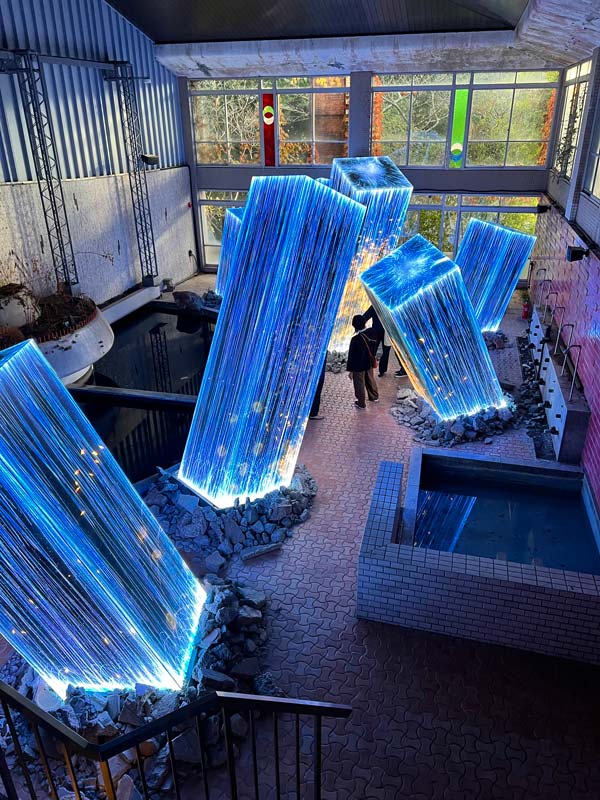
A former mountain spa plays host to an installation by one of the hottest art collectives in the world.
Glistening light displays
I’m amazed, then I am enthralled. The collective’s signature dancing digital light displays have been installed in an abandoned and dilapidated mid-20th-century spa. In an old public bath, the long-empty soaking pools and tiled floors are the canvas for vivid patterns that explode and writhe beneath my feet, as if responding to my presence.
In another room – complete with its original shower heads protruding from the walls – giant columns jut diagonally from the rubble of the site, slowly morphing in colour. I head deeper into the experience, down a dimly lit, alarmingly crumbling, disconcertingly inclined corridor towards a virtual flame at the bottom.
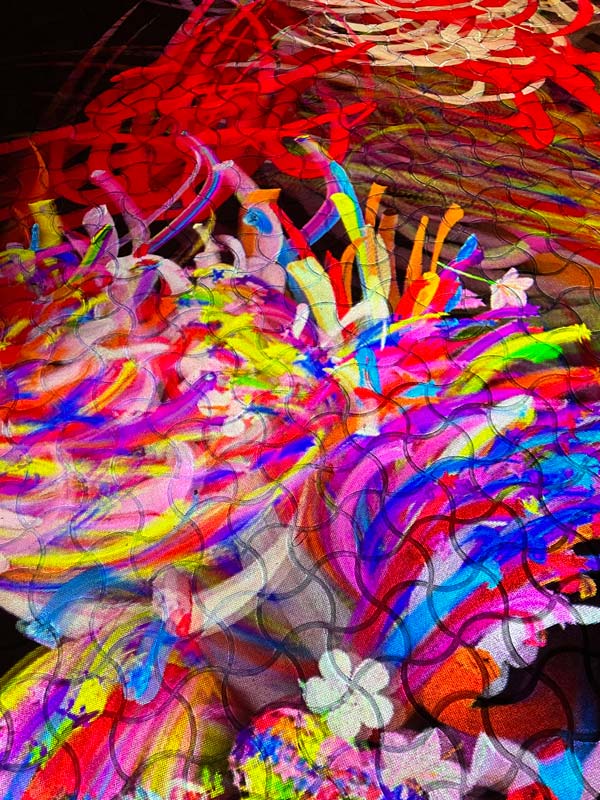
The installation is bursting with vivid colours. (Image: Leigh-Ann Pow)
Mirrored art installation
Moving on, I suddenly find myself in a corridor of numbered rooms with people navigating their suitcases through sliding shoji screens; for a split second I think this is all part of the show, but it seems I have breached an invisible line between the ruins and the functional. I follow the arrows marking the route to the next installation, a mirrored room filled with hanging lights that wax and wane between shades of cream, red and soft green.
It takes me a moment to realise that I am standing in the lobby of a functioning mountain retreat, complete with a discreet check-in desk. My unexpected diversion through a world-class art installation in a blissful mountain setting becomes a metaphor for my time in Kyushu.

The Main Forest and Spiral of Resonating Lamps – One Stroke is a sight to behold. (Image: Courtesy of teamLab)
What to expect
The third largest in the collection of four main islands that make up Japan, Kyushu is spread over seven prefectures – Fukuoka, Saga, Nagasaki, Kumamoto, Oita, Miyazaki and Kagoshima – but is easily traversed. The island has an outsized reputation, founded in violent volcanic eruptions and seething fissures that cut deep into the flesh of the landscape, but as I explore, I find the immensity of its allures in its finer details; the surprising, the small, the singular.

Kyushu is surrounded by endless seas dotted with countless islands, as seen looking out to Kujukushima (Ninety-Nine Islands) at Tenkaiho Observatory, Nagasaki Prefecture. (Image: Leigh-Ann Pow)
The small
Full disclosure: I love Japan. I have been returning to the country as if drawn to it by an invisible thread since my first visit as a teenager. In that time, I have island-hopped in Okinawa Prefecture, woken before the sun to sit in quiet reverence with chanting monks in Koyasan in Wakayama Prefecture, and travelled to the Oga Peninsula in Akita Prefecture to chase ogre (at the annual Namahage Festival).
But surprisingly, I have never been to Kyushu. I’ve dreamed of it though, largely due to its celebrated ceramics fairs, the principal one of which is held in the town of Arita, Saga Prefecture, during Japan’s Golden Week holidays from late April to early May.
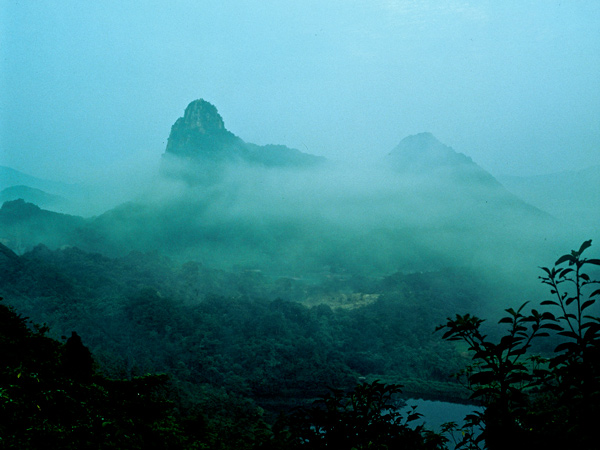
Fog envelops Mifuneyama Rakuen.
Pottery making at Autumn Ceramics Fair
I arrive in the town on the last day of the Autumn Ceramics Fair in late November (all ceramics fairs are good ceramics fairs as far as I am concerned), smaller but no less captivating.
With a storied history of pottery makers and kilns, the main thoroughfare of Arita’s old town is delightful in its modest proportions and Studio Ghibli-esque charm, lined with a hotchpotch of patinaed historic shops, their windows filled with blue and white ceramic designs, their footpaths crowded with baskets and shelves filled with teacups, dishes and bowls in a multitude of patterns.
The largely septuagenarian volunteers, pointing people in the direction of local restaurants and pottery workshops, huddle near a giant 1000-year-old ginkgo tree, its delicate golden leaves creating a luminous halo around its base as they flutter to the ground.
I take a pottery class under the tutelage of a gorgeously enthusiastic young artist at Pottery Studio Rokuroza, where, after donning an apron and wildly unflattering protective trousers and choosing a design (I opt to make a small pouring vessel, which will be glazed a gentle, creamy blue after I leave), I sit at a wheel nervously working the silky local clay this way and that.
In case the result of my handiwork is less than display quality, I rifle through some bargain baskets to find a few Y300 (roughly $3) cups to take home. A resolutely modern end to the quaint delights of Arita comes when I check into Arita Huis, a sleekly minimalist boutique hotel surrounded by a collective of ceramics stores, that would be at home in the design-conscious neighbourhoods of Tokyo or Kyoto.
A riot of concrete and blond wood, the sleek, clean lines in the lobby space are offset by an architectural ikebana (Japanese art of flower arranging) display at the entrance and a pool of small, floating ceramic orbs that create a quietly lyrical soundscape as they gently bounce off each other as the water shifts almost imperceptibly. In my loft-style room, I sleep contentedly, before waking to an exquisitely presented traditional Japanese breakfast of grilled fish and rice served at a communal table in the lobby.

The artist responsible for crafting these stunning ceramics is also responsible for making the soba noodles served at Noritou, a studio-cum-restaurant near Arita in Saga Prefecture. (Image: Leigh-Ann Pow)
The surprising
Much has been made of Kyushu’s volatile volcanic foundations, with the island continuously bubbling, seething and belching steam and heat. Oita Prefecture’s Chinoike Jigoku or Blood Pond Hell has become the embodiment of the island’s geological capriciousness, but a slightly less ominous take on the constant natural drama can be had in Unzen Onsen in Nagasaki Prefecture.
Part of the sprawling Unzen-Amakusa National Park, even the most cursory walk around this compact hot spring town, with its vintage corner store, toy shop and restaurants serving up colourful bowls of champon, a noodle soup that is a speciality of Nagasaki Prefecture, will offer up the sight (and pungent aroma) of steaming jigoku (hell) hot springs.
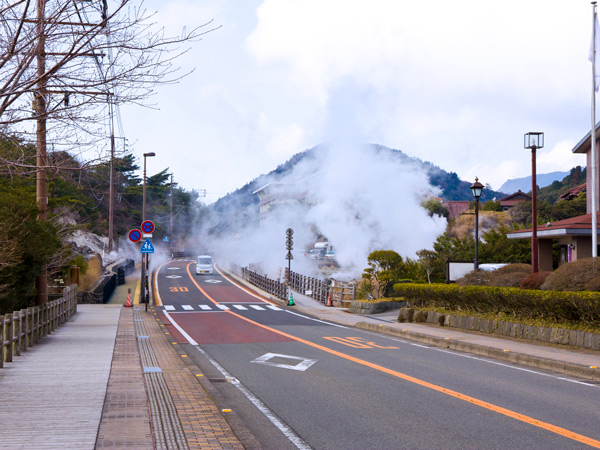
Steam rises from Unzen Hot Springs near Nagasaki.
Gliding through the Nita Pass Ropeway
While most come here to soak in the mineral-rich waters, one of the most breathtaking experiences is a ride on the Nita Pass Ropeway. A cable car by any other name, the adorable red cabin of the ropeway is like something straight out of the 1950s, so I appreciate the sartorial efforts of my guide for the day, Mr Tsunoda Shuji, who turns up wearing tweed and a jaunty little hat for our excursion.

The sartorial style of guide Tsunoda Shuji reflects the autumnal colours of Mt Myokendake. (Image: Leigh-Ann Pow)
The 500-metre ride up Mt Myokendake from Nita Pass takes three minutes, delivering me to 1300 metres above sea level. While the low clouds restrict my view on the pass side of the mountain, I find diversion in walking the short, narrow trails that lace the hardy foliage.
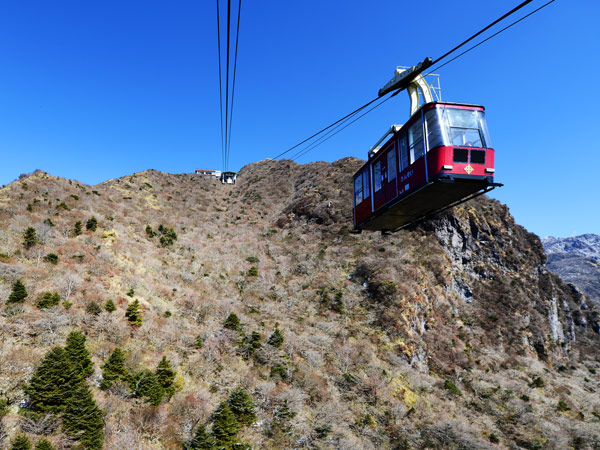
Nita Pass Ropeway provides easy access to Mt Myokendake.
At the end of one, I find a stunning view of an autumn-hued valley and a tiny honour box of fortunes (omikuji). I pay Y100 ($1) and unravel my fortune – a good one according to Shuji-san – and then tie it to the branch of a tree to magnify its effect, allowing the good luck to waft on the mountain breeze to whatever being of providence will now watch over me to make it a reality.
A stop at Fugendake, one of the main peaks of Mt Unzen, provides a view of one of the newest mountain peaks in Japan: Heisei-Shinzan. Formed almost overnight when lava pushed up from the Earth’s core as Mt Unzen rumbled and erupted in the 1990s, the before and after photographs are surprising evidence of Kyushu’s ever-changing topography as a result of fire and fury.
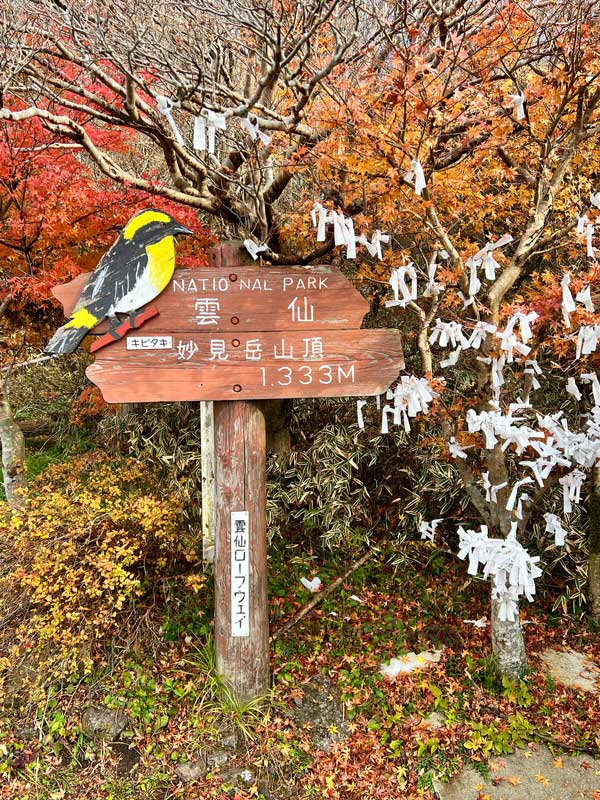
Fortunes are drifting at the top of Nita Pass.
The singular
The beauty of travelling in Japan is in the diversity of experiences to be had, often rendered singular by their unique regionality. This thought crosses my mind as I sit on a low, flat boat floating through Fukuoka Prefecture’s ‘Little Venice’.
The quiet, tree-lined waterways of Yanagawa are actually the remnants of the defensive moats that once protected this historic former castle town. The castle, originally built in 1588 and known as the ‘water castle’, was eventually decommissioned in 1873, but the snaking canal system it fostered remains.
Drifting through Little Venice
Settling into place, our expert oarsman launches his boat (donkobune) away from the edge of the water and plunges his long bamboo pole into its depths. As the mellow autumn sunshine glistens and glints off the surface, we glide past waterside parks and walkways, and skinny little houses that represent Yanagawa’s version of waterfront living.
Rambling bushes, weeping willows and flowering trees line the route, introducing delightful bursts of colour, while in other stretches distinctive sea cucumber walls (namako kabe), created in a crosshatch pattern of white and grey, appear at the water’s edge.
Suddenly, our oarsman bursts into song, reciting the melodic poems composed by Hakushu Kitahara. His tenor is matched by his expertise at navigating the many bridges that span the moats, many requiring a low duck to clear; technique is also required to punt the wide bridges without becoming stranded halfway.
My journey comes to an end at the grand Tachinabana Ohana, the traditional home of the Tachinabana family, where I am served a lunch of eel, steamed over rice and presented in a lacquerware box – a Yanagawa speciality – while overlooking a manicured garden.
A small town bustling with creativity, a violent and surprising change to an already dramatic landscape and a singular meal after a unique experience; the glory is indeed in the (finer) detail in Kyushu.

A canal-side store offers refreshments to those cruising Yanagawa’s canals. (Image: Leigh-Ann Pow)
A traveller’s checklist
Getting there
Japan Airlines has daily flights from Sydney to Tokyo (Haneda); JAL and ANA offer regular flights from Haneda to Fukuoka.
Staying there
Choose a trio of design hotels to stay in style: the impactful circular lobby at The Basics Fukuoka is lined from floor to soaring ceiling with books big and small, all of which guests can browse and read; REF Kumamoto by Vessel Hotels is another property that has a focus on books, with the bright and welcoming lobby dominated by a large communal reading table full of books, including plenty of manga.
The two-storey loft rooms at Arita Huis are stylishly simple in execution yet deliciously welcoming, echoing the exquisite Japanese minimalist lines of the lobby, with its eight-seat dinner counter overseen by chef Takashi Ikeda, gallery and shop.
Eating there
Japanese food is often described as a work of art, but at Noritou the chef crafting the bouncy, nutty 100 per cent buckwheat soba noodles (most soba noodles these days are cut with other flours, so these are the gold standard) is the same artist whose ceramics are on display as you sit in this delightful gallery-cum-restaurant.
The cold noodles come accompanied by soba-yu (soba water), which you dip the noodles in before slurping them from your chopsticks.
See noritou.com or visit the Kiln Arita Tourist Information Centre near the station for details and directions.
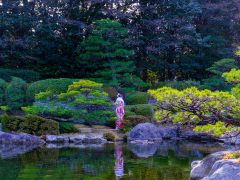
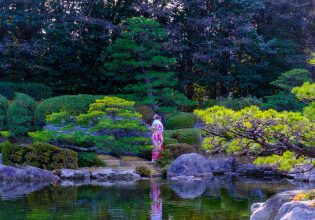
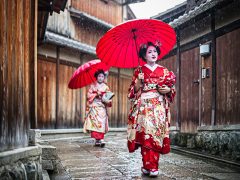

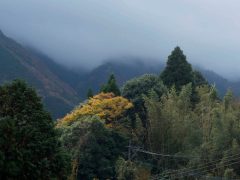

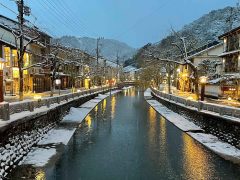

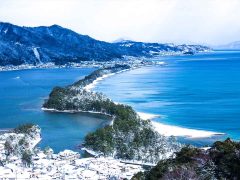


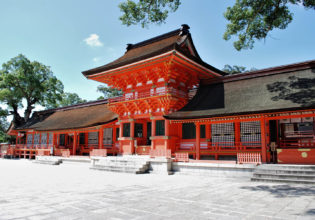


LEAVE YOUR COMMENT